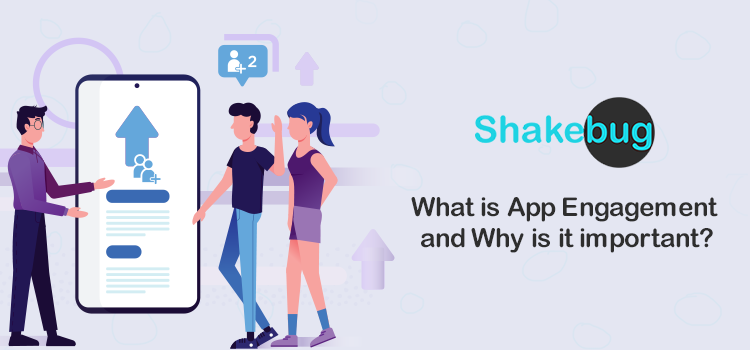Your mobile app user interface needs to be as seamless and intuitive as possible if you want it to truly engage your customers or users and make them want to use it again.
If you’re not getting the number of app engagement actions that you’d like, there are certain aspects of your app that you can change to improve user interactions and make your app better overall.
This article will teach you what app engagement is, why it matters, and how you can increase your own mobile app’s engagement by focusing on certain types of actionable behaviors that users can perform within the app itself.
What is app engagement?
App engagement is the measure of a user’s interaction with an app. The more engaged they are, the more likely they will be to open the app and make purchases or complete in-app tasks. This is important because app engagement can lead to higher conversion rates, which then leads to higher revenues for your company.
App engagement is the measure of how engaged a user is with an app on their device. The higher the number, the more engaged the user is with your app. When you create your app, you should always keep engagement in mind.
There are many ways to do this: use interactive features, provide incentives for usage and have a responsive design that makes it easy for users to navigate and see what your app has to offer.
Important engagement metrics to measure
1) Active users
One of the most important metrics to measure is the number of active users, which measures the number of people who use your app at least once a month. Active users are people who use your app more than once a month, log in more than once a week, or spend more than 20 minutes on the app every day.
Active users are one of the most important engagement metrics to measure because they’re what keep you afloat when everything else falls apart.
2) Retention
Retention is an important metric to measure when evaluating engagement. Retention measures the percentage of users who return to the app within a certain timeframe, usually a day or week. A high retention rate means that most people are coming back to use your app regularly.
The higher this metric is, the better chance you have of getting a user to come back to your app again.
3)Churn
One of the most important engagement metrics to measure is churn. Churn, which measures how many customers are leaving your application or service each month, can be valuable for understanding customer satisfaction with your app.
It can help you determine if there are any areas of your app that need improvement. For example, if you notice a high churn rate in one specific area of your app, then you may want to improve the usability or design of that part of the app.
4) Conversions
Conversions are an important engagement metric to measure because they show how your app is converting users into customers. The conversion rate can be defined as the number of new paying customers divided by the total number of installs.
There are different types of conversions, including in-app purchases, subscriptions, merchandise orders and more. An app with a high conversion rate means that many people are using your product or service and becoming paying customers.
5) Launches
Launches are a critical engagement metric to measure because they show how often users return to your app. Launches tell you how often users find value in your app, which will be different for everyone. For example, if a user launches an app twice per day then that’s great; however, if the same user only launches the app once every two weeks then that’s not so good.
6) Session duration and intervals
Session duration and intervals are important engagement metrics to measure. Session duration refers to the time elapsed between when a user opens the app and closes it. Intervals, on the other hand, measure how often an individual uses a given app in a given period. These can be measured by week, day, or hour.
Session duration and intervals can let you know if people are only using your app for a short time, or if they’re playing for hours and hours. This information can help you find ways to improve your app so that more people play it more often.
Related Read:- How to Streamline Your Mobile App Development Process?
Why is app engagement important?
Engagement is important because it tells you how often a user interacts with your app. The more they use your app, the more successful you will be. If they don’t use your app, then they are not going to see all the benefits of having downloaded it in the first place. Plus, there is a good chance that they will delete the app if they aren’t satisfied with what’s offered.
App engagement is important because the more time users spend with your app, the more likely they are to keep using it. If they use your app every day, they’re much less likely to uninstall it. According to Google, 52% of people will use an app only once if they’re not happy with their experience. This means that by increasing app engagement, you’ll decrease the likelihood of users unsubscribing or uninstalling your app.
Tips to increase user engagement
Increasing user engagement is a process of increasing the frequency, depth, and breadth of interactions that users have with your app. It’s essential to keep your app users engaged. The more engaged they are with your product, the more likely they will purchase something or make a repeat purchase.
These four tips will help you increase user engagement:
1. Offer incentives for referrals – You can offer rewards to customers for referring new customers. This will get them excited about sharing their love of your product with their friends and family members.
2. Ask for reviews – Encourage current users to provide feedback on what they like and don’t like about your product so that you can improve future iterations and products based on customer feedback.
3. Be social – Make use of social media by posting pictures of your product on Instagram or tagging posts related to your business with relevant hashtags on Twitter. By being active on social media, you’ll create buzz around your company while engaging current users as well as potential ones.
4. Use emojis – Using emojis in texts and messages will increase user engagement because people respond better to words than just letters. adding emoji faces might encourage people to buy from your store because it makes it seem more personable.
These four tips will help you increase user engagement within your application and consequently promote conversion rates.
Conclusion
The best way to increase app engagement is to find out what your users want from you. You can do this by asking them questions, observing them, or experimenting with different features. This will give you a better understanding of how to tailor your app for the best experience for each user.
It’s important to engage with your users because they are the lifeblood of any company. Without these customers, there would be no product or service to sell to make money!


